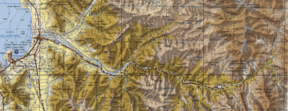Elqui River
| Elqui River | |
|---|---|
 The Elqui River on the map | |
| Origin | Junction of Turbio River and Claro River (Elqui) |
| Mouth | Pacific Ocean |
| Basin countries | Chile |
| Source elevation | 815 m[1] |
| Basin area | 9,826 km²[1] |
The Elqui River starts in the west Andes, flowing into the Pacific Ocean, crossing the Chilean city of La Serena, is a wine and pisco producing area. Vicuña, its main town, was the home of Nobel Laureate poet Gabriela Mistral.
Ancient Indigenous Culture of the Elqui Valley
Several authors argue that the first community that populated the valleys of Chile's Norte Chico were the Molle people, which initially combined farming with hunting and gathering to become, over time, full-time farmers along with the development burnished red pottery, and did work with stone and copper. Notable archaeological sites are Alcohuaz and Cochiguaz where soil and water were available for fruitful farming.
They were advanced in their use of technology, as evidence of their knowledge of metallurgy and its practical applications shows. In the first stage of their development they worked copper by smelting and hammering it and later used gold and silver alloys, as well as employing techniques of rolling, drawing, and embossing. Later on around 1000 A.D. the Diaguita people arrived in the same area. They were named by the archeologist Ricardo Latcham for their similarities to the Argentine Diaguita. They made contact with the Molle culture, from whom they learned to work with copper and other metals. Their pottery consisted of asymmetric, wide mouth, containers, with a handles and usually rendered with red, black and white geometrical motifs.

Over time the Diaguita people began to form their own identity and broke free from the influence of the Molle and reached a growing autonomy. Also of interest is the totemic pottery tradition wherein zoomorphic and anthropomorphic vessels were fashioned. Called duck jugs, they consisted of a hand sculptured human-like head coming out of one side and an opening for filling and pouring on the other side, both of which were joined by a curved handle. The whole thing was painted with fine geometric patterns. In Las Placetas near Paihuano, burial sites from the classic period have been identified which demonstrate the use of land for crops and pasturing. Three Diaguita cemeteries were also discovered nearby.
During the heyday of the Diaguita, some 550 years ago, the Inca Empire expanded down into present day Chile from Peru, and they were invaded and put under the dominion of the Incas.
Inca culture influenced the Diaguitas by improving their agricultural production, care of livestock, and employment of mining and domestic industries such as pottery and textiles. The Incas also provided bowls, jugs with handles on top in animal forms, and new decorative motifs such as triangles and checkerboard stripes.
See also
- Pisco Capel
- Julio Alberto Mercado Illanes
References
| Wikimedia Commons has media related to Elqui Valley. |
- ↑ 1.0 1.1 (Spanish) Cuenca del río Elqui
| ||||||||||
Coordinates: 29°53′40″S 71°16′30″W / 29.89444°S 71.27500°W
